
|
||
|
Portland art blog + news + exhibition reviews + galleries + contemporary northwest art
|
||
The darkness will hold, for now I have been thinking about motivations for criticism lately. Art criticism is more than a simple popularity contest aimed at amusing or endearing oneself (or your employer) to the art scene or an exercise in lazy caricatures that ignore the details and context at hand for snark's sake (that has a place as social theater but isn't criticism). Instead, it's about context and sharing a process of perceptual evaluation. What's more it seemed like it was time to explore a group of current shows with a mutual thread around the darkness of Winter and Portland's predilection for niorish
arcana:
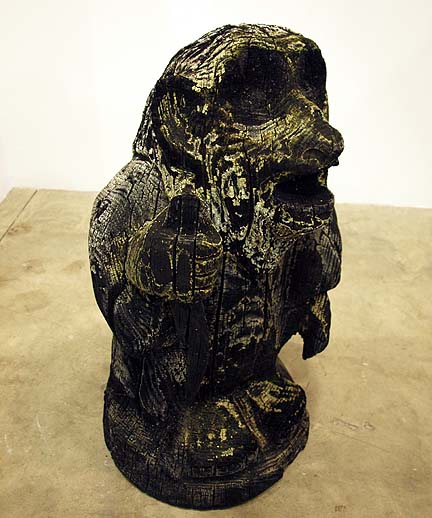 Matthew Green's Nibog at Fourteen30 (photo Jeff Jahn) Dark: A Show to Winter at Fourteen30 appropriately ends tomorrow (a week before the Spring Equinox). Typical of the Blood Family Rainbow's curatorial collaborations it has a dark, gothic, even occult focus. It's a good show with the first room being significantly stronger than the others. This is partially because 3 of the 4 best pieces (By Matthew Green, Sven Stuckenschmidt and Molly Vidor) are in the first room. The strongest by far is Matthew Green's Nilbog (goblin spelled backwards), which has become the show's mascot. If it were a person it would be the cult leader of this group of dark souls. What makes Nilbog important is it is quite genuinely the product of a ritualized burning. By fetishing a simple chainsaw sculpture and burning the piece becomes a totemic anthropological place marker, an analog of a bog man that preserves its ritual killing, freezing it in a silent yet horific/humorous state. Nilbog mutely stands as a proxy sentinel of some mute set of laws and social codes we the non Blood Family members as visitors must confront. Its mute provocation stands for "the other"… we have clues to its condition but nothing further. Frankly, Nilbog is the only thing in the show that is significantly better or at least more genuine than anything Banks Violette has ever done. Let's just say Violette is the show's neo-goth, dark metal lov'n patron saint and a lot of the other work in the show has the same semi-crafty, semi-subculture riffing we've all been seeing en masse for over half a decade because of Violette's success. 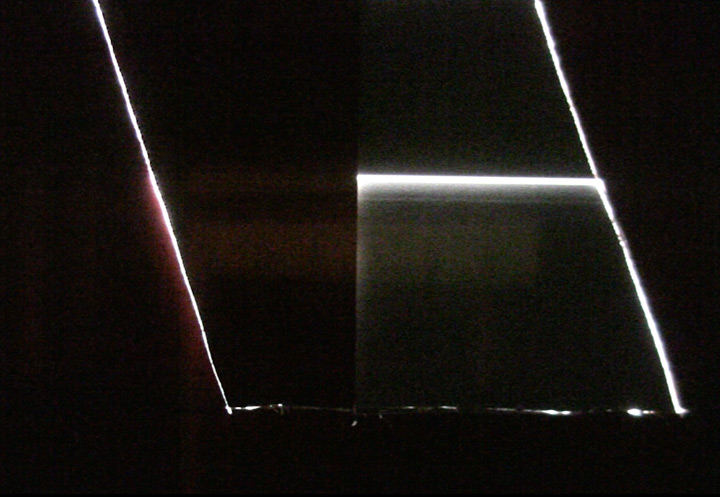 Alex Hubbard, The Paranoid Phase of Nautical Twilight I-III, Video Still Nilbog is better because it isn't fetishing some obvious subculture lifestyle as much as a manifesting a legitimate primal urge, transformed and given form through ritual. Till now Green has been a merely promising recent art school grad making still very "art school" work (i.e. it riffed on subcultures in clubby, "ha I get it so we are both cool" ways). Nilbog is something else and goes much deeper, nobody gets it, nobody can... it's not just a dark piece, it's a silent apophenia producing sentinel; simple, hilarious, serious and terribly effective. The fourth strong piece in the show is Alex Hubbard's excellent video, The Paranoid Phase of Nautical Twilight I-III… a dark channeling of Gordon Matta Clark style structural cutting in video. His other video in the show though is an unimaginative and twee rip-off of Fischli and Weiss' classic the Way Thing's Go, we expect better of the former Portlander. 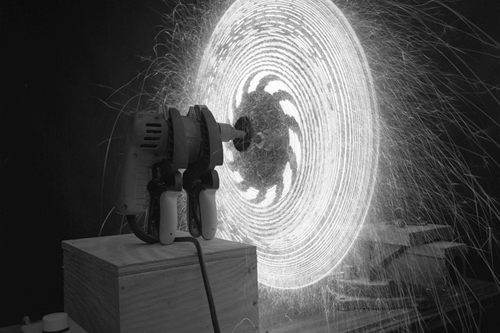
Caleb Charland's Demonstrations series at Bluesky Another excellently dark show is Caleb Charland's Demonstrations at Bluesky. His haunting black and white time lapse photographs of moving light sources recall Nicolai Tesla's fantastic coils (which are most easily visualized as the devices used to bring Frankenstein's monster to life in the 1931 film version). There is something haunting about Charland's photographic mad scientist antics… like a really talented poltergeist at work. Bean Gilsdorf wrote this excellent review of a related photographic show The Eye of Science. 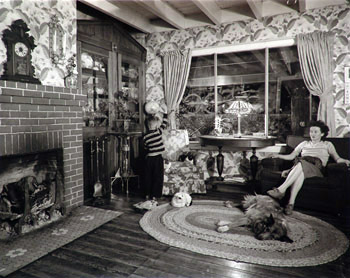 O. Winston Link's Living Room on the Tracks, Lithia, Virginia, 1955 Right next door another at Charles Hartman Fine Art is O. Winston Link's show of uneasy railroad photographs The Last Steam Railroad in America. This show also ends on Saturday. Normally one doesn't associate choo choo's with a gothic sensibility but some of these like Living Room on the Tracks could be right out of a David Lynch's Twin Peaks. There's just something alchemical about transforming hard dark coal into steam to propel giant cast iron and steel machines. Don't miss this show… the iron horse as a niorish demonic force or at least a symbol of unstoppable fate is quite compelling and it says a lot about America's drive. Is that drive gone with the great steam locomotives? 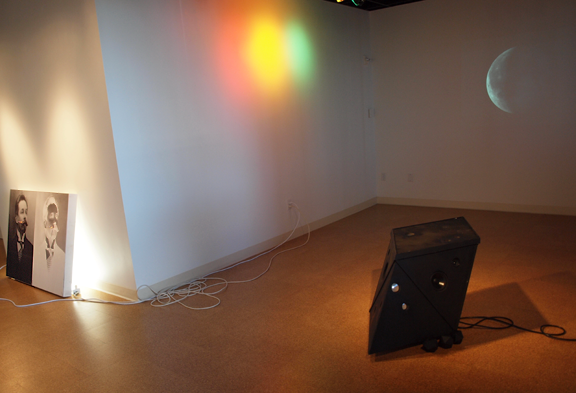
Jack Ryan at PCC Cascade Gallery (photo Jeff Jahn) Another excellent but dark show is Jack Ryan's Scriabin's Moustache at PCC Cascade Gallery. Featuring somewhat arcane sound/sculpture, flickering light sources and a video called "Moon Rise" of the moon cycling from full to crescent with unnatural speed, the show feels like a séance for the haunting genius that was composer Alexander Scriabin. This is yet another excellent show from PCC cascade, which has become the most consistently adventurous university gallery in Portland this season. Sculptural/sound elements like the piece Black Parallelogram/after Tony Smith explore the arcaneness of Scriabin the composer and highlight a similar arcaneness in sculptor Tony Smith's black forms. Sometimes to be ahead of your time the things that artists create have to feel out of their time… or "weird" (weird is a word derived from the Old English (via Nordic) idea that one can know their fate or "wyrd"). Scriabin was a brilliant if completely eccentric composer and died of a carbuncle, which grew in his moustache then ruptured with tragic results. Perhaps Ryan is creating a metaphor for odd fate and its effects as the legacy of an artist, which others then inherit and similarly pass on? Very moving and reminiscent of shows at Small A gallery, except better because it substitutes odd arcaneness for that onetime Portland venues' Brooklyn-esque irony fetish (something I often find an easy audience finding crutch, others love it). Of Walking in Ice @ White Box Gallery, U of O Portland Similarly, Jack Ryan has also curated a show called, Of Walking in Ice at the U of O's White Box Gallery in the White Stag Building. It shares a lot of similarities with his solo show, not the least of which being both are rather arcane. Of Walking in Ice comes from Ryan's interest in a text by the rather arcane filmmaker Werner Herzog where he chronicled a chilly walk from Munich to Paris by a young filmmaker. The interpretations, be they Melody Owen's intertwined infinity symbol snowshoes, Anna Fidlers' Daniel Richter-esque figures in a landscape or Anna Gray and Ryan Paulson' literary index, all display an elliptical sense… perhaps because when walking on ice there is this sense of endlessness. On an iced over lake or ice cap the surfaces is relatively uniform and white, giving little hint of scale, direction or shelter. Once again fate seems to be at play here but since Herzog is involved one senses there is an utter conflation of the absurd, artistic and legitimate documentation. Overall, this theme of darkness isn't anything new for the area, In 2002 Stuart Hordoner curated the noirish "Northwest Narrative" at PICA's once glorious full time exhibition space. More recently Laura Fritz, Carl Diehl, OPS, Stephen Slappe, Paula Rebsom, Patrick Rock, Arnold Kemp, Michael Brophy, Dan Attoe have put on haunted sanity challenging efforts. In the tradition of David Lynch, this noirish suspension of reason for generating apophenia is a great strength of Portland's art scene because it deals in intangibles and the unknown (all very common themes for a settlement carved out of the deep dark woods rather recently). Posted by Jeff Jahn on March 12, 2010 at 17:09 | Comments (0) Comments Post a comment Thanks for signing in, . Now you can comment. (sign out)
(If you haven't left a comment here before, you may need to be approved by
the site owner before your comment will appear. Until then, it won't appear
on the entry. Thanks for waiting.)
|
| s p o n s o r s |
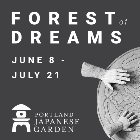 |
 |
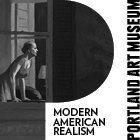 |
 |
 |
 |
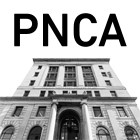 |
 |
 |
 |
 |
 |
 |
 |
 |
 |

|
Site Design: Jennifer Armbrust | • | Site Development: Philippe Blanc & Katherine Bovee | |

